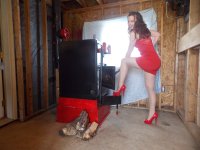I was in a very similar situation as you, my home being super efficient but using a propane boiler for a radiant heated home. I have hundreds of acres of forest, so I thought maybe wood would save me money over that of buying propane. I looked at gassifier indoor boilers, yet after the stove dealership and I crunched the numbers, even he concluded that the gassifier return on investment would not be good. In other words, I would be better off to just buy propane since by the time the gassifier was repaid in savings, it would be junk.
In my case, I found a used $700 boiler for sale and bought that instead. It is not as efficient as the gasifier, but the return on investment was a lot less too.
You seem to be in a very similar boat, except you already have wood heat so you do not need to buy anything. I would just keep what you have, and as others have said, get better windows or insulation maybe. My super-efficient home has come about because I visualize it turned upside down and filled with water. Any place water could run out, I worked at stopping up.
Good score BT. My house is so poorly insulated as a log home that when I filled the house with water and turned it upside down, not only did all the water evacuate, but the kids got flushed out as well.
